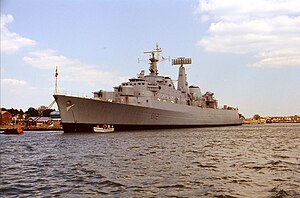| HMS Kent (D12) | |
|---|---|
 HMS Kent | |
| Career (UK) | |
| Name: | HMS Kent |
| Ordered: | 6 February 1957 |
| Builder: | Harland & Wolff, Belfast |
| Laid down: | 1 March 1960 |
| Launched: | 27 September 1961 |
| Commissioned: | 15 August 1963 |
| Decommissioned: | 1980 |
| Struck: | 1993 |
| Identification: | Pennant number: D12 |
| Fate: | Sold for scrap in 1998 |
| General characteristics | |
| Class & type: | County-class destroyer |
| Beam: | 53 ft (16 m) |
| Propulsion: | COSAG (Combined steam and gas) turbines, 2 shafts |
| Aircraft carried: | 1 × Lynx or Wessex helicopter |
HMS Kent was a batch-1 County-class destroyer of the Royal Navy. She and her sisters were equipped with the Sea Slug Mk-1 medium range surface to air missile SAM system, along with the short-range Sea Cat SAM, two twin 4.5" gun turrets, two single 20mm cannon, ASW torpedo tubes, and a platform and hangar that allowed her to operate one Wessex helicopter. The Counties were large ships, with good seakeeping abilities and long range, and were ideal blue-water ships for their time.
Operational Service[]
After her commissioning and work-up, Kent spent the balance of her career as an escort to the RN's aircraft carrier fleet. She deployed at various times with HMS Victorious, HMS Eagle, and HMS Hermes in the Atlantic, Indian, and Pacific Oceans. She was hard worked throughout the 1960s, along with her batch-1 County sister ships, as they were the only guided missile armed destroyers in the fleet until the later half of the 1960s.
One role was as host ship for the Withdrawal from Empire negotiations in Gibraltar. She suffered a fire during refitting in 1976 but was soon repaired and was present for the Silver Jubilee fleet review of 1977. All four of the batch-1 Counties were to have mid-life refits and the superior Sea Slug Mk-2 system fitted, however this was cancelled due to the mid-70's cut-backs of RN funds and Hampshire and Devonshire paid off early in 1976 and 1978 respectively. Some of the improvements in the second group of County destroyers, were fitted, HMS Kent and London, had their Seacat directors updated from GWS21 to GWS22 and the later model of 992 radar target indicator was on HMS Devonshire, Kent and London, by May 1974. Kent was decommissioned in the summer of 1980 and became the replacement for HMS Fife and Fleet Training Ship (FTS), moored to the lower end of Whale Island outboard of the defunct support ship HMS Rame Head opposite Fountain Lake, Portsmouth Naval Base. At the beginning of the Falklands War she was surveyed for possible recommissioning (her large size, helicopter deck and four 4.5" Guns would have made her a good Command and shore bombardment ship), but her two years of unmaintained status meant a substantial amount of refit would be required to make her sea worthy, and no work was begun. She spent 1982 through to 1984 as a live asset for artificer and mechanic training supporting HMS Collingwood and HMS Sultan, her machinery largely in servicable condition. In 1984 she also became a Harbour Training Ship for the Sea Cadet Corps. She was paid off from this in 1987 and became a training hulk at Portsmouth until stricken in 1993, though she lingered on, tied up to the same pier at Portsmouth Naval Base until 1996.
HMS Kent was sold for scrap and in 1998 she was towed to India to be broken up.[1]
Commanding officers[]
| From | To | Captain | |
|---|---|---|---|
| 1968 | 1970 | Captain Iwan Raikes RN | |
| 1971 | 1977 | Captain Jock Slater MVO RN | |
| 1977 | 1979 | Captain Richard Turner RN |
1979 1980 Captain J P Gunning RN
See also[]
| Wikimedia Commons has media related to HMS Kent (D12). |
- List of ship launches in 1961
- List of ship commissionings in 1963
- List of ship decommissionings in 1980
References[]
Publications[]
- Colledge, J. J.; Warlow, Ben (2006) [1969]. Ships of the Royal Navy: The Complete Record of all Fighting Ships of the Royal Navy (Rev. ed.). London: Chatham Publishing. ISBN 978-1-86176-281-8. OCLC 67375475.
The original article can be found at HMS Kent (D12) and the edit history here.